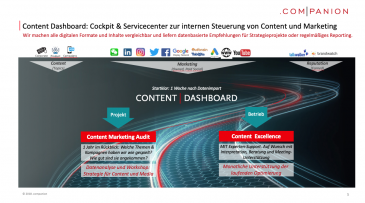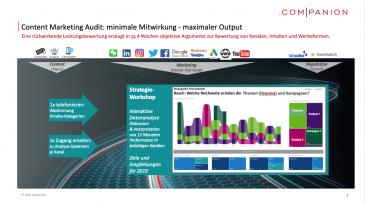In a long text, as is often the case with us, it is about the company's internal view of key figures, analytics and "data-driven". If you scroll straight down, you'll find our method for a lean strategy project, the Content Marketing Audit. A smart thing to do for your 2019 annual planning.
Synchronizing digital marketing communication - a mammoth task
Owned, Web, Earned, Paid, Organic, Native, Display, Video, Search, Social Media...anyone responsible for digital communication in a company can be glad if there are any uniform terms at all in their own house for the chaotic agile zoo of digital channels and formats. At the latest, colleagues in the other business unit use different terms, not to mention agencies.
Experience shows that digital marketers have to reconcile an average of around 10 different digital platforms and channels and sometimes just as many agencies. They all have to be synchronized in coordinated processes - if you have the one plan and goals that everyone actually adheres to. However, such a common goal orientation is an ideal state.
Anyone in a company with central responsibility for planning, creating, publishing and promoting digital content and campaigns knows this and cannot complain about boredom. He or she faces a mammoth task.
Digital metrics - almost always part of the problem. And not the solution
How to define goals, how to enforce a framework for all stakeholders, how to evaluate success? Digital metrics, the infamous "KPIs" that every platform monopolist, media silo and agency usually dice up to suit their own interests, are not considered particularly helpful in this context. Rightly so.
Inconsistent evaluation standards exacerbate the lack of transparency and contradictions in the digital media arena, and comparisons with the budget elephants in the traditional media genres (TV, etc.) are systematically made impossible. On the part of Facebook and Google, marketers, publishers and also agencies, this is by design. No reproach, but in business life, who voluntarily faces up to transparency and comparability that may result in disadvantages for oneself?
KPIs, even digital ones, are associated with a systemic problem: They always serve to justify their senders. They obfuscate and cause chaos in the executive suite. Every marketer knows the helpless feeling, sometimes even the anger, when "analytics" or "digital KPI", even 20 years after their beginnings, "still present themselves as a "secret science" that provides "oracles" at best.
It doesn't have to stay that way. Companies must and can gain control over their own KPIs and all the raw data that goes with them. However, this requires the courage to simplify and carefully organized mandates to centralize the management of content and media. Whether "News Room" or "Content Factory" for content; whether "Campaign Center" or "War Room" for creation and media, only with an organizational decision to bundle at least parts of the responsibility for content and marketing via a central analysis layer can companies escape the intransparency of digital media and get into the driver's seat for digital marketing themselves.
Drive internal standardization with digital key figures
Our content marketing dashboard shows that KPIs for digital media performance can also be processed in a different way, namely clearly, fairly and simply. Everything, regardless of the digital channel, whether it's a sales or awareness campaign, from video ads and AdWords to individual content in web pages and social posts, is evaluated uniformly and comparably. (If you want to try it out: it only takes a week to go live, a demo is possible at any time).
Our 3 Digital KPIs, which are always the same, are a prerequisite for ensuring that the diverse planning and publication processes in the communications and marketing departments can be coordinated at all. The reason: the digital experts get a common language. The 3 KPIs work the same way in every media silo. They are simple and ensure comparability. This makes many things easier, especially evaluating the quality of digital content and the performance of digital advertising formats. But the evaluation doesn't work without interpreting the media data.
Because in everyday management, there is no such thing as "Programmatic". There is also no "Real Time, or other dull and stupid processes that take place only between computers. Instead, there are sophisticated conversations between people. That's the only way decisions are made in companies: in team dialog, or at least after team dialogs in which data expertise and business expertise are brought together.
"Data Learning" - Data Must Be Interpreted
A basic rule of Data Science, which "generally refers to theextraction of knowledge from data," states that data can only create value if "data knowledge," i.e., our statistical analyses, come together with so-called "domainknowledge," i.e., the company's expertise, e.g., on the product and context of the individual communication measures. Only from this fusion of knowledge do reliable interpretations and ultimately recommendations for action emerge; only in this way can we say goodbye to conjecture, speculation or, as they say in Westphalia, "Spökenkiekerei".
Knowledge fusion is therefore necessary. It can only happen in a meeting. Meetings that use data are the door, the key and the lock to "Data Driven" in the company. If you want to become a data driver, you have to be a team player.
Data learning - decisions must be derived and implemented
What meetings are we talking about? Well, for example, a strategy workshop- with a mandate to decide on annual planning. Or about a well-embedded Jour Fixe - with a decision mandate about topic planning,
In both meetings, the 2 core components of the engine for data-driven value creation are working
- The regular interpretation of data with systematic derivation of recommendations for action
- The following is the implementation in the form of decisions.
Interim conclusion: In addition to non-transparent computer operations, recently often called AI, "artificial intelligence," SI "social intelligence," namely that of teams that decide, is the only engine for data-based value creation. "Insights" or "Analytics" without decisions are worthless. "Reports" or "dashboards" change nothing if they lead to no action. Data hogging without consequences is a pure waste of time and money. What matters are data-based actions - by people or by computers.
Data learning in the organization is the real challenge
It is well known that computers make data-based decisions. The metaphor for this is "algorithm". It is also possible for people in companies to make data-based decisions. But for this to happen, analyses and KPIs must be integrated into decision-making processes. The conversion to data-based decision-making processes is the real challenge on the company side.
How good that right now, in the course of annual planning 2019, so many relatively simple decision-making situations are pending or can be brought about. Annual planning 2019 is an ideal opportunity to familiarize yourself with data-based workflows and decision-making processes as part of a project.
Best opportunity to kickstart: use data to align 2019 marketing and content strategy
Target planning for the next year can also be supported by those responsible for marketing and communication in this way:
- You decide which topics, campaigns and channels you want to have evaluated independently and neutrally based on performance data.
- They give us unique access to analytics systems in web, social and advertising.
- Three weeks later, you interpret the key results of the data analysis with us in a data learning workshop. In the content marketing dashboard, we look at the performance and efficiency of all the digital content you selected over the last 12 months. You will learn what was published and promoted, how it was received by the target groups, how efficient channels were, whether advertising funds were used or not - and above all: what follows from this for the objectives in 2019?
The corresponding product offering from us is called Content Marketing Audit. We look forward to your call!



